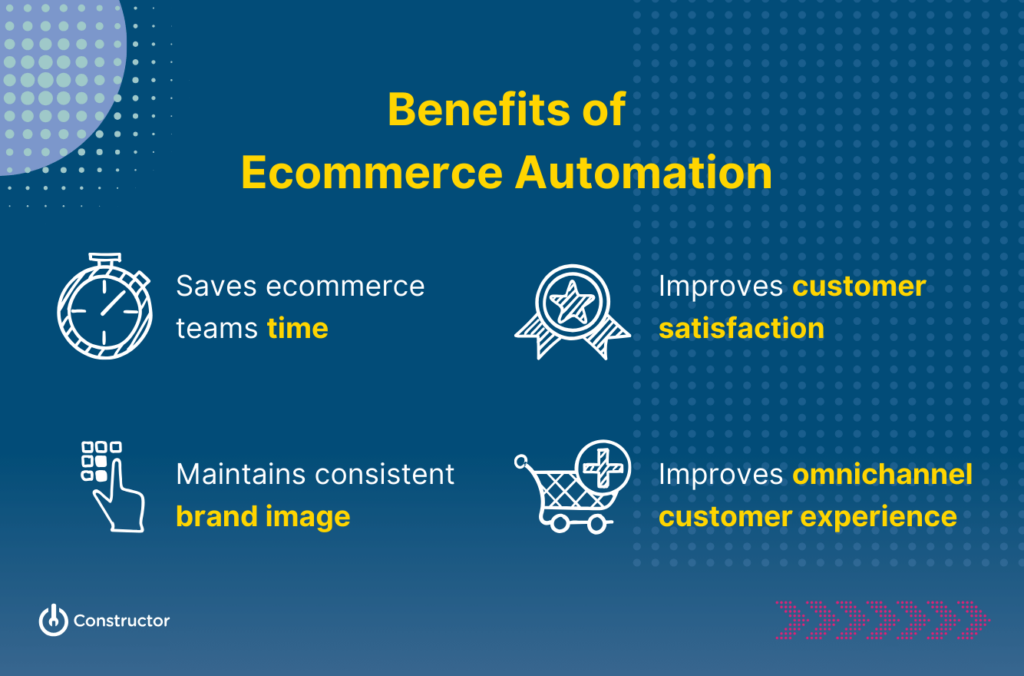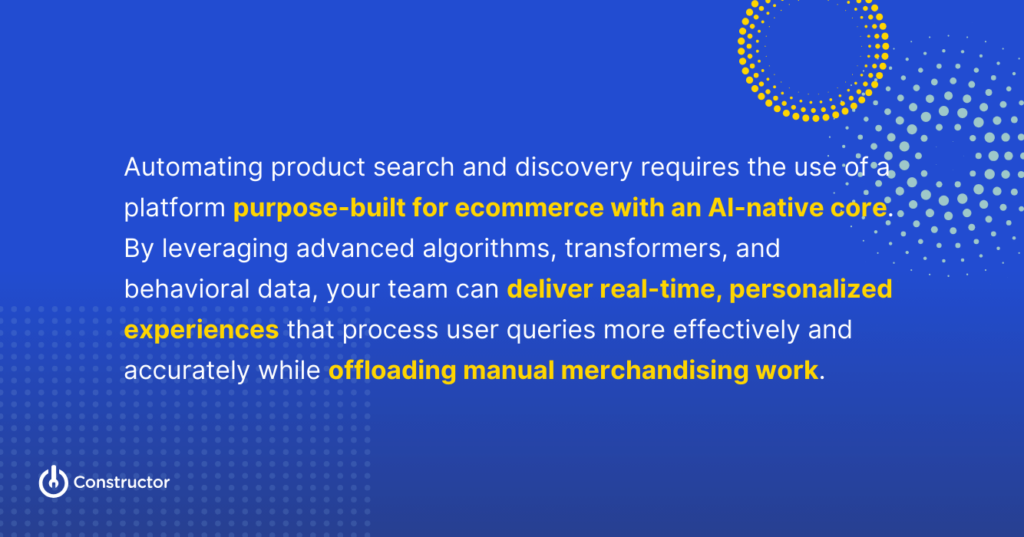In today’s fast-paced ecommerce landscape, automation is the driving force behind streamlined operations, improved efficiency, and enhanced customer experiences. Understanding and implementing automation is no longer an option, but a necessity for staying competitive.
Let’s take a look at some of the tools and practices that can free up your team’s time for creative, strategic tasks and fundamentally change how your business operates.
About Ecommerce Automation
Ecommerce automation refers to the use of technology and software to streamline and optimize various aspects of your business.
The overarching goals of ecommerce automation is to reduce manual tasks and human error, increase efficiency, and improve the overall customer experience. It encompasses a wide range of processes, from inventory management to marketing, product discovery, and more.
Benefits of Ecommerce Automation
Ecommerce automation offers numerous benefits, making it an essential part of any strategy for staying competitive and meeting business goals. When ecommerce automation is implemented effectively, it can lead to gains across the board.
Here are some key advantages automation offers businesses.

Saving merchandising teams time
Where there exists a time-consuming, manual process, there is an automated workflow just waiting to take over.
For instance, automation tools can schedule and send marketing emails, social media posts, and advertisements at optimal times, saving marketers the effort of doing this manually. Automation can also analyze customer behavior and preferences to provide real-time product recommendations, which saves customers time in finding what they want and provides Customer Success teams more data and insights to improve customer relationships.
And when it comes to searchandising, ecommerce automation can drastically reduce the lift required of online merchants, giving teams more time to focus on strategic business initiatives.
Maintaining consistent brand image
It’s old news that a strong brand creates a community of loyal, connected customers –– a key part of any successful ecommerce business. While it can be tricky to maintain a predictable brand image that resonates with consumers and brings in sales, ecommerce automation can lessen the burden on teams.
For example, AI-powered recommendation algorithms can suggest tailored products that complement a customer’s purchase history and shopping behavior while simultaneously prioritizing business KPIs, aligning with a brand’s goal of providing value while hitting key metrics.
Automation can also leverage data analytics to create targeted marketing messages. This personalization within the framework of the brand’s identity can enhance customer engagement and lead to a loyal customer base.
Improving the omnichannel customer experience
A great omnichannel customer journey involves corralling and parsing through lots of data, from both online and offline channels. Analyzing that data is key to individual personalization, but it doesn’t have to be painful with the right ecommerce automation tool.
For instance, AI-powered product discovery tools use data from various channels to personalize product result sets, ensuring a cohesive customer experience. This omnichannel experience aids in upsells, customer loyalty, and a positive customer journey.
Improving customer satisfaction
From faster order processing to real-time inventory updates and tailored marketing messages, meeting (and exceeding) customer expectations — thanks to ecommerce automation — is likely to bring repeat purchases, word-of-mouth recommendations, and overall long-term business success.
Types of Ecommerce Automation Software
There are so many different kinds of ecommerce automation solutions available to streamline manual and time-consuming tasks. The key is identifying what aspects of your business (and which teams) need that help the most.
Here are some common types that might give your business the automatic boost it needs:
Product search and discovery
Automating product search and discovery requires the use of a platform purpose-built for ecommerce with an AI-native core. By leveraging advanced algorithms, transformers, and behavioral data, your team can deliver real-time, personalized experiences that process user queries more effectively and accurately while offloading manual merchandising work.

PIMs/PXMs
Does your product experience management strategy need a boost? Consider investing in a Product Information Management / Product Experience Management (PIM/PXM) solution like Akeneo, which provides a single place to store, manage, and enrich product data. This ensures consistency across distribution channels, accelerates adaptation to market changes (especially with new products), and improves operational efficiencies.
Ecommerce platforms
Serving as the foundation of your entire operation, choosing the right (read: headless) ecommerce platform can set you up for success right away. These platforms provide built-in automation tools for analytics and reporting, payment processing, product listing, inventory management, customer relationship management, and more. Notable contenders for enterprise ecommerce include BigCommerce and Salesforce Commerce Cloud.
CMS platforms
Small but important non-product content tasks like creating image alt text and meta tags can be achieved with the use of a Content Management System (CMS) platform, like Amplience and Contentstack. Incorporating a CMS helps you optimize your existing site for SEO and empowers non-technical teams to react quicker to changing customer expectations when necessary. CMS platforms are yet another technology predicted to evolve with the rise of generative AI.
Other types of ecommerce automation software
From real-time inventory tracking and reorder alerts to email marketing and social media scheduling tools, automation exists for most areas of marketing, sales, inventory, and order fulfillment.
Where to Start With Ecommerce Automation
Nearly every aspect of the online shopping experience can be improved with ecommerce automation. So, the first step is deciding which areas of your business need it most. Where are your numbers stagnating? What are your customers saying? For instance, if you’re struggling to maintain positive customer sentiment, beginning there may be a good idea.
Also, when searching for the right solution, keep in mind your nice-to-haves and what you consider to be deal-breakers. For example, if you’re hoping to strengthen your current personalization strategy, make sure to place product search and discovery at the top of your must-haves.
As with many things in business, ecommerce automation is a journey. It empowers innovation and adaptability and helps deliver the ultimate goal of creating a memorable experience for customers — all while making merchandisers’ lives just a little bit easier and driving bottom-line results.

